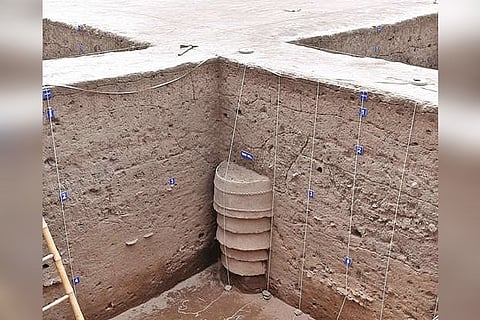

Chennai
“This season, we aim to carry out scientific analysis in all possible aspects like residue analysis, pathology study, palaeobotanical study and pollen analysis,” B Chandramohan, Secretary (Tourism, Culture and Religious Endowments) told DT Next.
The State government is keen on these excavation works because they throw more light on the early civilisation. “As early as 580 BC, there was a civilisation with high standards of urbanisation and this is a matter of pride. During this period, specialisation and an advanced relationship of trade and commerce with far-off regions like Gujarat had existed in TN,” explained Chandramohan. “The artefacts and findings from these excavation sites are revealing,” the top official added.
“The seventh season of Keeladi and its cluster excavation began on February 13 this year and the archaeological excavations at other sites on February 26,” said Director (Archaeology) R Sivanantham. The Kondagai archaeological excavation is taken up for the second season to focus on the burial pattern and practices. This season aims to carry out scientific analysis in all possible aspects like residue analysis and pathology study. Similarly, the Adichanallur site is located on the right bank of the Tamiraparani River and another fascinating site is Sivagalai in the same Thoothukudi district. Sivagalai is a habitation-cum-burial site and the excavation work for the habitation site will soon be taken up, the official said.
“The main objectives of the excavations are to locate the earliest settlement of the region, to understand the potentiality of the Iron Age and early historical culture and its transition and to study the evolution of Tamil-Brahmi (Tamil) script,” explained Sivanantham.
The Maligaimedu, Gangaikondacholapuram in Ariyalur district is another treasure trove for archaeologists. The temple Gangaikondacholeeswaram is a world heritage monument and is under the control of the Archaeological Survey of India. Since Maligaimedu is at the vicinity of Ganigaikondacholapuram, which was ruled by Rajendra Cholan-I (1012 -1044 CE), son of Rajaraja Cholan (985-1014 CE), the excavation is taken up by the TN Department of Archaeology to expose the possible foundation of the palace remains belonging to Chola rulers. “The main objectives of this excavation are to expose the foundation of the palace and its extension; to reconstruct the palace based on structural remains and epigraphical resources,” Sivanantham said.
“We are working to understand the plan of the palace and its relation with inscriptions and to estimate the way of palace life through ceramic pieces of evidence such as Chinese potsherds. This will also reveal the Chola period township pattern confirming the political, social and economic status in a given landscape and collecting iron objects such as armour and weapons to establish the existence of an ancient army and kingdom in TN. At present, three trenches with 12 quadrants were opened. So far, many antiquities like iron objects, celadon ware, potsherds, a copper coin were collected and excavation is in progress,” Sivanantham added.
According to Tamil Nadu Archaeological department sources, Kodumanal is located in Perundurai taluk in Erode is also promising and this site is located on the northern bank of Noyyal River, a tributary of the Cauvery. Most of the excavation sites are closely connected to the river system of TN like Vaigai, Cauvery, Noyyal and Tamirabarani.
The significance of Kodumanal is evident from the textual references to it as a trade-cum-industrial centre in Sangam literature. ‘Padirruppattu’ (dated around the early part of the Common Era) referred to this village as ‘Kodumanam’. The site lies on an ancient trade route that connects Karur, the ancient capital of Cheras, in the east to the ancient seaport of Muziri on the west, sources said.
Visit news.dtnext.in to explore our interactive epaper!
Download the DT Next app for more exciting features!
Click here for iOS
Click here for Android